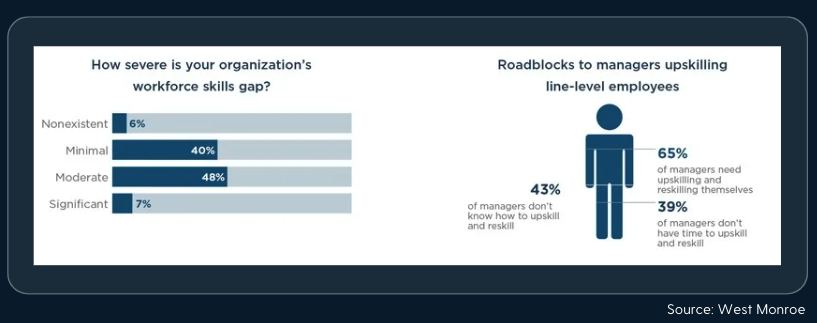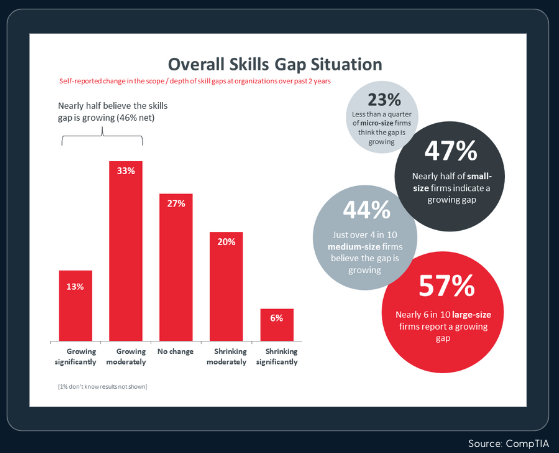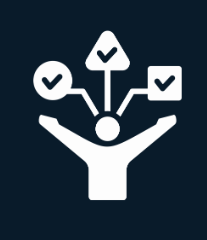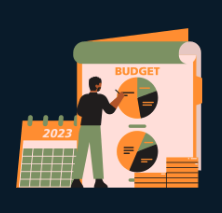
Leading Blind? Why Your Workforce Skills Gap Might Be Costing You
What is the Skills Gap?
The skills gap refers to the disparity between the skills that job seekers possess and the skills that employers seek in their employees. In today’s dynamic job market, technical skills have become vital for success, but many employers need help finding qualified employees who possess the necessary skill sets to fill open positions.
This significant skills gap can lead to challenges for both employers and job seekers, making it essential to address the issue head-on.
Causes of the Skills Gap
Rapid Technological Advancements
The modern era is characterized by a breakneck pace of technological advancements, with new tools and platforms continually reshaping the landscape of various industries..
Changing Industry Standards and Regulations
As industries evolve, so do the standards and regulations that govern them.
This dynamism calls for a workforce that is not only compliant with current norms but is also prepared to adapt to future shifts.
Educational System Limitations
owering fashion with clean energy sources like solar and wind is another step towards a sustainable future. Renewable energy helps reduce greenhouse gases and create a more responsible industry.
Mismatch of Skills and Job Requirements
Occasionally, a discrepancy exists between the skills possessed by job seekers and the actual requirements of the job market. This mismatch could stem from unclear job descriptions or a disconnect between educational programs and industry needs.
Migration and Brain Drain
This phenomenon, known as brain drain, can create a vacuum of expertise, necessitating strategic approaches to retain talent and foster skill development within the local context.
Identifying Skills Gaps in the Workplace
Engaging in Cross-functional Dialogues
Recruiters can initiate cross-functional dialogues within the organization, fostering an environment where different departments openly discuss the existing skills in their teams and identify where they might be lacking.
Developing Skill Matrices
Creating skill matrices for various roles within the organization can be a structured approach to identifying skills gaps. These matrices can map out the skills required for each role, providing a visual representation of the areas where the organization needs to focus its skill development initiatives.
In-depth Job Analysis
An in-depth job analysis goes a long way in identifying skills gaps. Recruiters should spend time understanding each role in detail, mapping out the skills required to excel in those roles.
Competency-based Interviews
Conducting competency-based interviews for existing employees can be a unique approach to identifying skills gaps. These interviews can focus on understanding the employees’ proficiency in their respective areas, helping recruiters to map out the skills landscape in a structured manner.
Workshops and Focus Groups
Organizing workshops and focus groups where employees can discuss their experiences and challenges can provide recruiters with qualitative data on skills gaps.

The Impact of the Skills Gap
Stagnation of Career Growth and Employee Advancement
The skills gap can hinder individual career growth and advancement opportunities. Employees who lack the necessary skills to move up the career ladder may find themselves stuck in their current roles, and lack of visibility to which skills they lack leaves them stumped. This can lead to dissatisfaction, decreased motivation, and increased turnover — all of which negatively impact your workforce.
Additionally, with advancements in artificial intelligence technology and automation, workers will often need to hone or develop new skills to better work with technology — or even support new areas of the business. When it comes to employee development, there’s nothing as certain as change, and with the right programs to support continuous improvement, your business can be better prepared to pivot to meet new challenges.
Struggles in Innovation and Competitiveness
Today, innovation is everything, regardless of the industry. Everyone is continually looking to the next big technological advancement to improve their lives.
The skills gap poses a significant threat to innovation by limiting the availability of skilled workers who can contribute fresh ideas and perspectives. Organizations that lack the necessary expertise may struggle to adapt to new technologies and market trends, hindering their ability to remain competitive.

Benefits of a skills gap analysis

Provides insight into employee expertise
Analyzing skills gaps helps you determine which team members have the necessary skill levels for certain areas of your business and identify what roles employees’ skills are best suited for. Knowing this is also essential for focusing on areas where staff may need to improve.

Supports learning and development
A skills gap analysis highlights your individual strengths and weaknesses. This allows you to focus on targeted learning opportunities that bridge your skill gaps and set you on a path to achieving your career goals.

Improves hiring and recruiting
L&D and HR professionals can use the data from a skills gap analysis to find and hire candidates with the necessary skills that fulfill various roles. This in turn can help your organization better meet business objectives for future growth and provide insights when planning and implementing learning and development programs for employees.

It creates a competitive advantage
If you combine all of the above, you’ll be able to create a competitive advantage and stay ahead of your competition. You’ll know the strengths and weaknesses of your workforce. That way, you can better plan for learning and development and recruitment to optimize your organization’s performance.
Industries affected by skill gap over the world
The skills gap is a global phenomenon that affects various industries across different regions. Here are some industries commonly affected by the skills gap worldwide:

Information Technology (IT)
- With the rapid advancements in technology, the demand for skilled IT professionals such as software developers, cybersecurity experts, data analysts, and cloud computing specialists continues to outpace the supply.
- Emerging technologies like artificial intelligence, machine learning, and blockchain are creating new roles that require specialized skills, exacerbating the skills gap in the IT sector.

Healthcare
- Healthcare systems worldwide face shortages of skilled professionals, including nurses, physicians, medical technicians, and allied health workers.
- Aging populations, increased demand for healthcare services, and evolving healthcare technologies contribute to the skills gap in the healthcare industry globally.

Manufacturing and Engineering
- The manufacturing sector experiences shortages of skilled workers such as machinists, welders, industrial engineers, and robotics technicians.
- Technological advancements in manufacturing, such as automation and advanced materials, require workers with specialized skills that are often in short supply.

Construction and Skilled Trades
- Construction industries around the world face shortages of skilled tradespeople, including carpenters, electricians, plumbers, and HVAC technicians.
- Factors such as an aging workforce, declining interest in skilled trades among younger generations, and lack of vocational training contribute to the skills gap in construction.

Finance and Accounting
- Financial services organizations require professionals with expertise in areas such as financial analysis, risk management, compliance, and data analytics.
- The finance industry faces challenges in attracting and retaining talent with the necessary skills to navigate complex financial markets and regulatory environments.

Energy and Renewable Resources
- The energy sector, including oil and gas, renewable energy, and utilities, experiences shortages of skilled workers such as engineers, technicians, and project managers.
- Rapid changes in energy technologies and the transition to renewable resources create demand for workers with specialized skills in areas such as solar energy, wind power, and energy storage.

Retail and Hospitality
- Retail and hospitality industries require employees with customer service skills, digital literacy, and knowledge of sales and marketing techniques.
- The skills gap in these industries is exacerbated by changes in consumer behavior, technological innovations in e-commerce and hospitality services, and the need for personalized customer experiences.
Strategies to bridge the skills gap
1. Understand what skills your organization or country needs.
Ask yourself (or your team): What specific skills does your country or business need workers to possess? Answering this question can help you build a pipeline of workers suitably trained for the future labor market that requires both digital and relational skills, whether in regular employment, entrepreneurial ventures, or the gig economy. The best way to answer it is with national skills maps, or an overview of all the skills future employees will need not just technical and job-specific skills, but emotional, relational, and communicative ones as well. The maps should include standardized definitions and methods that measure whether or not a skill has been learned.
2. Leverage corporate training outside of corporations.
Many corporations have internal skills development platforms that help current employees acquire new skills. But what about their future employees?
By pairing elements from best-of-class corporate programs with a government-led national policy framework, stakeholders can jointly help establish a high-quality national skills development program that is germane to national and local populations, efficiently achieves scale, and doesn’t need to be built from the ground up.
3. Develop a regional and/or national skills forum to improve information sharing among all key stakeholders.
Sharing information about skills development across regions and even countries is an important part of solving the youth unemployment crisis. Why? Because the half-life of skills is short and getting shorter. We need a skills-in-demand forecasting engine that cuts across regions and industries. It takes employers, educators, government officials, and professional associations to work together to address trends in the job market, identify skills gaps, and support the programs that youth need to thrive.
4. Build a national digital skills verification trust.
Beyond interviews, aptitude tests, and online portfolios, employers lack a standardized, low-cost way to verify the skills new employees claim to have — regardless of their formal education level. Creating a global or national verification system enables employers to identify the most useful skills for their current employees and set up new hires for success by indicating what additional training they should consider. Although micro-credentials and digital badging are a start, a national system built on a technology platform such as a distributed ledger or Blockchain will help employees track and store their skill base and provide employers with a trusted and easily verifiable assessment method.
conclusion
The skills gap presents a significant challenge in today’s job market, impacting employers and job seekers alike. To bridge this gap, we must strengthen education and training systems, foster public-private partnerships, and embrace technology-driven solutions. By promoting continuous learning and identifying emerging skill requirements, we can build a stronger and more competent workforce prepared for the dynamic demands of the future. Addressing the skills gap is not just a necessity; it is a pathway to a more prosperous and thriving society.